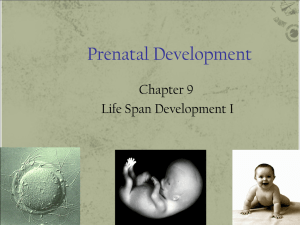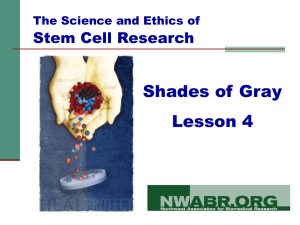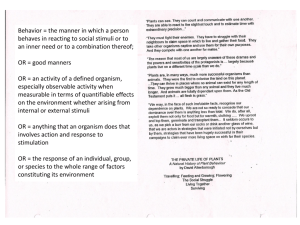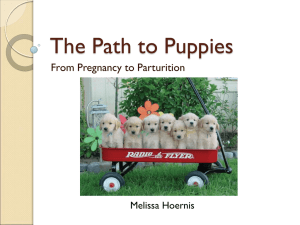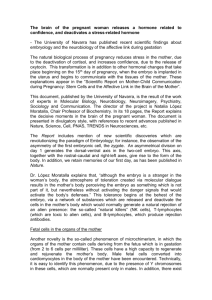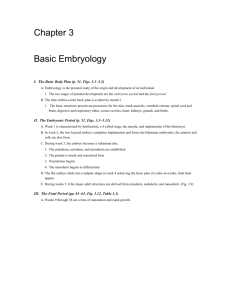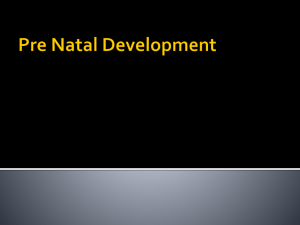"Insemination and Generation or Sowing and Dawning: La Venta as... Creation Story."
advertisement
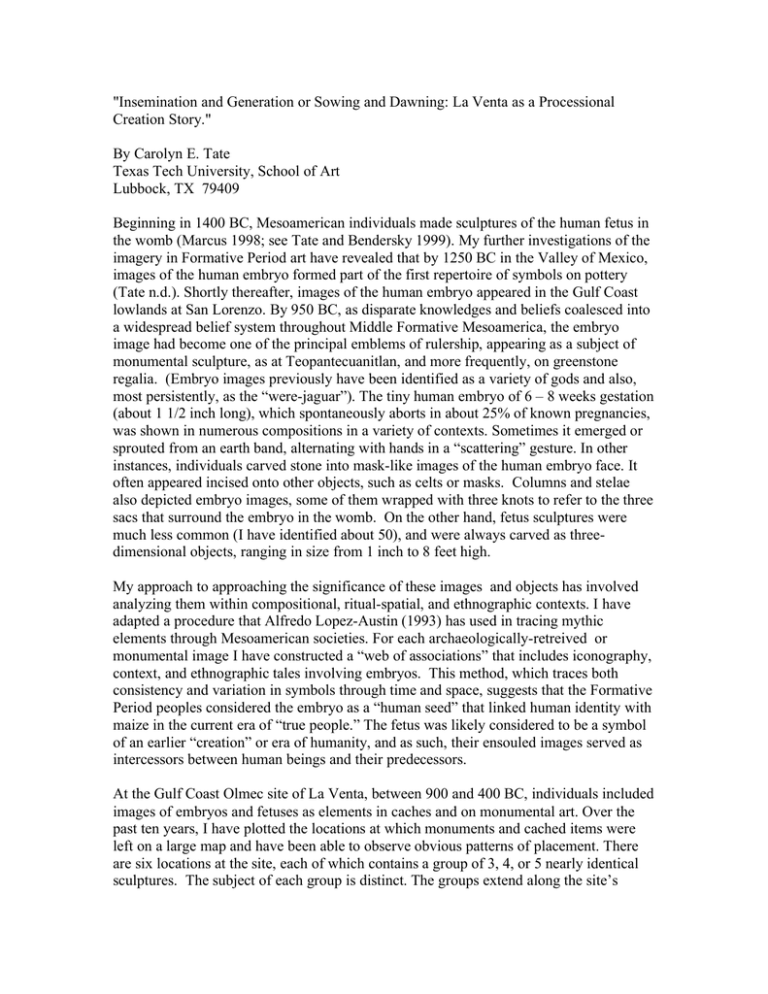
"Insemination and Generation or Sowing and Dawning: La Venta as a Processional Creation Story." By Carolyn E. Tate Texas Tech University, School of Art Lubbock, TX 79409 Beginning in 1400 BC, Mesoamerican individuals made sculptures of the human fetus in the womb (Marcus 1998; see Tate and Bendersky 1999). My further investigations of the imagery in Formative Period art have revealed that by 1250 BC in the Valley of Mexico, images of the human embryo formed part of the first repertoire of symbols on pottery (Tate n.d.). Shortly thereafter, images of the human embryo appeared in the Gulf Coast lowlands at San Lorenzo. By 950 BC, as disparate knowledges and beliefs coalesced into a widespread belief system throughout Middle Formative Mesoamerica, the embryo image had become one of the principal emblems of rulership, appearing as a subject of monumental sculpture, as at Teopantecuanitlan, and more frequently, on greenstone regalia. (Embryo images previously have been identified as a variety of gods and also, most persistently, as the “were-jaguar”). The tiny human embryo of 6 – 8 weeks gestation (about 1 1/2 inch long), which spontaneously aborts in about 25% of known pregnancies, was shown in numerous compositions in a variety of contexts. Sometimes it emerged or sprouted from an earth band, alternating with hands in a “scattering” gesture. In other instances, individuals carved stone into mask-like images of the human embryo face. It often appeared incised onto other objects, such as celts or masks. Columns and stelae also depicted embryo images, some of them wrapped with three knots to refer to the three sacs that surround the embryo in the womb. On the other hand, fetus sculptures were much less common (I have identified about 50), and were always carved as threedimensional objects, ranging in size from 1 inch to 8 feet high. My approach to approaching the significance of these images and objects has involved analyzing them within compositional, ritual-spatial, and ethnographic contexts. I have adapted a procedure that Alfredo Lopez-Austin (1993) has used in tracing mythic elements through Mesoamerican societies. For each archaeologically-retreived or monumental image I have constructed a “web of associations” that includes iconography, context, and ethnographic tales involving embryos. This method, which traces both consistency and variation in symbols through time and space, suggests that the Formative Period peoples considered the embryo as a “human seed” that linked human identity with maize in the current era of “true people.” The fetus was likely considered to be a symbol of an earlier “creation” or era of humanity, and as such, their ensouled images served as intercessors between human beings and their predecessors. At the Gulf Coast Olmec site of La Venta, between 900 and 400 BC, individuals included images of embryos and fetuses as elements in caches and on monumental art. Over the past ten years, I have plotted the locations at which monuments and cached items were left on a large map and have been able to observe obvious patterns of placement. There are six locations at the site, each of which contains a group of 3, 4, or 5 nearly identical sculptures. The subject of each group is distinct. The groups extend along the site’s central axis, which was marked with five stone columns. I have proposed that these groups form a narrative series that was engaged performatively as persons moved from south to north along the central axis. Not only that, but the successive groups contain many elements common to known creation stories in Mesoamerica, along with other elements that are specific to the Formative Period. In this presentation, I’ll illustrate and discuss possible meanings for the creation story at La Venta as it unfolded along the narrative stations. From colossal fetuses on a wombshaped U group to the phallic columns of red and green stone that penetrate the site’s surface, to ballgame –related symbols, the site of La Venta expressed unions of female and male on all conceptual scales, from human womb and seed to female earth and male rain, initiated cycles of sprouting, birth, and growth, or as the Maya later expressed it, “sowing and dawning.” The peoples who created this vast narrative brought conceptual elements –and also raw materials-- that had originated at various locations across Mesoamerica to create a coherent, and probably culturally unifying, statements about the roles of humans-- male and female, commoner and hero-- within larger cycles of nature and cosmos. The earliest Mesoamericans found the processes of all biological life so powerful that they made maize seeds and “human seeds” --embryos and fetuses— the principal symbols of a sacred transformational vital energy that they perceived. While such transformation was most evident as seeds sprouted and became plants and while the embryo (of humans and other animals) rapidly metamorphosed from a tadpole-like state to a tailed being to a form related to that of its species, it continued once a being was born. It is well known that Mesoamericans viewed the human life cycle as parallel to that of maize. Humans matured, flowered (in terms of physical beauty and reproductive capacity), produced seed and fruit, and finally withered and died. La Venta’s attempt to codify a creation story shares many traits with the slightly later one recently discovered at San Bartolo. López-Austin, A. 1980. The Human Body and Ideology: Concepts of the Ancient Nahuas. Salt Lake City: University of Utah Press. —. 1993. The Myths of the Opossum: Pathways of Mesoamerican Mythology. Salt Lake City: University of Utah Press. Marcus, J. 1998. Women's Ritual in Formative Oaxaca: Figurine-making, Divination, Death, and the Ancestors. Vol. No. 33. Memoirs of the Museum of Anthropology, University of Michigan. Ann Arbor: Museum of Anthropology, University of Michigan. Tate, C. E. in press-a. "The Colossal Fetuses of La Venta and Mesoamerica's Earliest Creation Story," in Imagining the Fetus:. Edited by V. Sasson. —. in press-b. "Olmec Knowledge of the Human Body and Gestation," in The Encyclopaedia of the History of Science, Technology, and Medicine in Non-Western Cultures. Edited by H. Selin. Dordrecht, The Netherlands: Kluwer Academic Publsihers. —. n.d. 2005. Unmasking the Embryo: the Emergence of the Human Embryo in Olmec art and Contemporary Scholarship. Tate, C. E., and G. Bendersky. 1999. Olmec Sculptures of the Human Fetus. Perspectives in Biology and Medicine 42:303 - 332.

